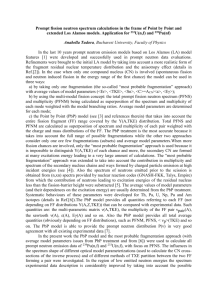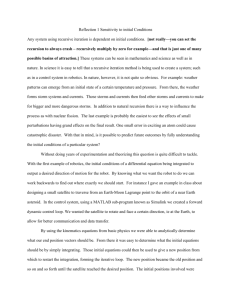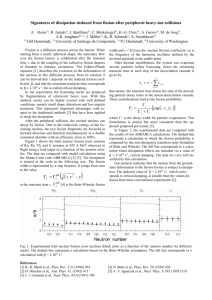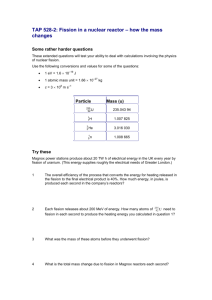B. Geslot - IGORR: International Group on Research Reactors
advertisement
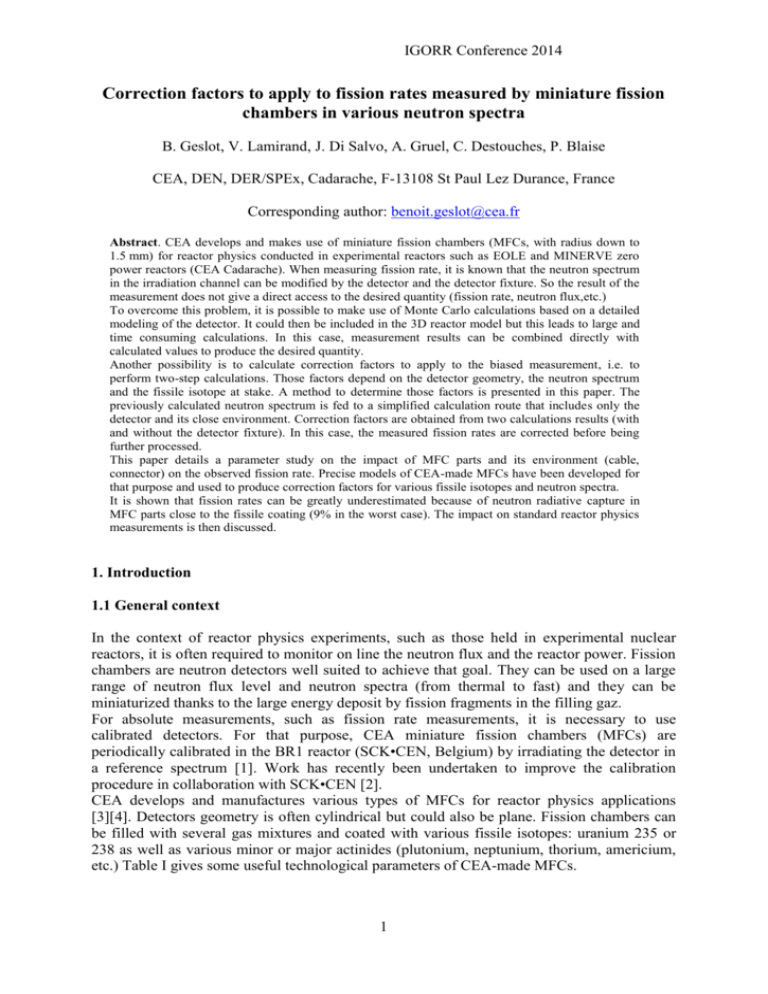
IGORR Conference 2014 Correction factors to apply to fission rates measured by miniature fission chambers in various neutron spectra B. Geslot, V. Lamirand, J. Di Salvo, A. Gruel, C. Destouches, P. Blaise CEA, DEN, DER/SPEx, Cadarache, F-13108 St Paul Lez Durance, France Corresponding author: benoit.geslot@cea.fr Abstract. CEA develops and makes use of miniature fission chambers (MFCs, with radius down to 1.5 mm) for reactor physics conducted in experimental reactors such as EOLE and MINERVE zero power reactors (CEA Cadarache). When measuring fission rate, it is known that the neutron spectrum in the irradiation channel can be modified by the detector and the detector fixture. So the result of the measurement does not give a direct access to the desired quantity (fission rate, neutron flux,etc.) To overcome this problem, it is possible to make use of Monte Carlo calculations based on a detailed modeling of the detector. It could then be included in the 3D reactor model but this leads to large and time consuming calculations. In this case, measurement results can be combined directly with calculated values to produce the desired quantity. Another possibility is to calculate correction factors to apply to the biased measurement, i.e. to perform two-step calculations. Those factors depend on the detector geometry, the neutron spectrum and the fissile isotope at stake. A method to determine those factors is presented in this paper. The previously calculated neutron spectrum is fed to a simplified calculation route that includes only the detector and its close environment. Correction factors are obtained from two calculations results (with and without the detector fixture). In this case, the measured fission rates are corrected before being further processed. This paper details a parameter study on the impact of MFC parts and its environment (cable, connector) on the observed fission rate. Precise models of CEA-made MFCs have been developed for that purpose and used to produce correction factors for various fissile isotopes and neutron spectra. It is shown that fission rates can be greatly underestimated because of neutron radiative capture in MFC parts close to the fissile coating (9% in the worst case). The impact on standard reactor physics measurements is then discussed. 1. Introduction 1.1 General context In the context of reactor physics experiments, such as those held in experimental nuclear reactors, it is often required to monitor on line the neutron flux and the reactor power. Fission chambers are neutron detectors well suited to achieve that goal. They can be used on a large range of neutron flux level and neutron spectra (from thermal to fast) and they can be miniaturized thanks to the large energy deposit by fission fragments in the filling gaz. For absolute measurements, such as fission rate measurements, it is necessary to use calibrated detectors. For that purpose, CEA miniature fission chambers (MFCs) are periodically calibrated in the BR1 reactor (SCK•CEN, Belgium) by irradiating the detector in a reference spectrum [1]. Work has recently been undertaken to improve the calibration procedure in collaboration with SCK•CEN [2]. CEA develops and manufactures various types of MFCs for reactor physics applications [3][4]. Detectors geometry is often cylindrical but could also be plane. Fission chambers can be filled with several gas mixtures and coated with various fissile isotopes: uranium 235 or 238 as well as various minor or major actinides (plutonium, neptunium, thorium, americium, etc.) Table I gives some useful technological parameters of CEA-made MFCs. 1 IGORR Conference 2014 TABLE I: CEA cylindrical miniature fission chambers characteristics FC type CF4 CF8R CF8Rgr Diameter (mm) 4 8 8 Active length (mm) 10 24 24 Deposit Anode Cathode Both Max. Watertight mass (mg) ~0.5 No ~5 No ~10 No Application ZPR ZPR ZPR MFCs are usually made of titanium parts and a connector allows plugging them on organic coaxial cables. As they are not watertight, they can only be used in air channels. They come in two outer diameters depending on the amount of fissile material required for the measurement: Ø4 mm (CF4) for less than 200 µg of fissile coating or Ø8 mm (CF8R or CF8Rgr) for coatings up to a few mg. Detectors active length are respectively 10 mm and 24 mm. CF8Rgr is a new detector design that allows putting two fissile deposits, one on each electrode. The gap between electrodes is also reduced in order to improve charge collection. 1.2 Goal of the parameter study Although MFCs are small and made of materials that slightly interact with neutrons, it is known that the transmission line conveying the signal to the electronic module (detector, connector and signal cable) has a local effect on the neutron flux as well as a global effect on the core reactivity. The impact on the measured fission rate is negative (i.e. the observed fission rate is lower than the unperturbed fission rate). Our main objective is to quantify this effect on the observed fission rate in order to correct it as efficiently as possible. A parameter study is required because the effect is expected to vary greatly depending on several parameters: detector design (geometry, materials), neutrons energy spectrum and fissile isotopes in the fissile coating. In order to quantify and correct any effect on fission rates, it is possible to make use of Monte Carlo calculations using a precise modeling of the detector and its close environment. It could then be included in the reactor model but this leads to large and time consuming calculations. Another possibility is to perform a two-step calculation, i.e. to feed a previously calculated neutron spectrum to a simplified calculation route that includes only the relevant elements. Correction factors are then obtained from two calculated results (with and without the detector). This paper details a parameter study on the effect of miniature fission chambers parts and its environment (connector and signal cable) on the observed fission rate. The simplified geometry route described above is used for that purpose. Precise models of CEA-made MFCs have been developed. We determine correction factors for various fissile isotopes and neutron spectra. This study is based on calculations using MCNP5 [5]. To assess our method, the simplified calculation route is compared to a whole core calculation in the case of the MINERVE reactor in the MAESTRO configuration [4], representative of à LWR UO2 spectrum. 2. Description of the calculation route 2.1 Monte Carlo modeling MCNP5 associated to JEFF3.1 library is used to model the detectors based on the schematics shown in FIG. 1. 3D Models were constructed very precisely and include as few approximations as possible in order to allow sensitivity studies. However, some 2 IGORR Conference 2014 simplifications were introduced for complex parts such as threads and feed-through, but materials masses were conserved. Actual materials were modeled but only by introducing the most significant alloy grades (for instance only stainless steel grade is used for all stainless steel components). It is to be noted that the fissile deposit is not included in the model because its mass and thickness are very small (typically 1 mg and 1 µm). It has been shown that there is no neutron self-shielding inside the fissile deposit [6]. (a) Ø4 mm cylindrical FC Connector Cable Fissile deposit (b) (c) connector cable (d) FIG. 1. Drawings used for the MCNP modeling of the CF4 with connector and cable (a), CF8Rgr (b), CF8R (c) and their connector and organic cable (d). Signal cables are shielded cables with copper core, polyethylene insulator, copper shield and plastic jacket. In order to insure a good calculation convergence despite the very precise detectors modeling, a simplified calculation route must be used. The transmission line (composed of the detector, connector and signal cable) is placed in a spherical neutron source which energy spectrum is quantified using the aforementioned spectra. Fission rates are obtained from a F4 tally volume defined in the inter-electrode gap (see FIG. 2 in the CF8Rgr case). Fission rates are calculated in dummy materials. This makes it possible to obtain a 0.3 % convergence with a 2 billion statistics. It has not been chosen to increase the tally volume, for instance by including the anode volume. This could have been done by diluting the anode materials in the tally volume with an adjusted density. On the contrary, we chose to be as close as possible to the real detector in order to avoid any modeling bias. 3 IGORR Conference 2014 FIG. 2. MCNP plotter views of the CF8 detector and spherical surface neutron source. YZ view (left) and XY view (right). Tally volume is shown in white on XY view. 2.2 Neutron spectra Three neutron fission spectra are considered in the study (see FIG. 3). The so-called thermal spectrum corresponds to the spectrum obtained in the thermal cavity of the BR1 reactor. It is very close to a purely Boltzmann spectrum at 300 K (maximum at 26 meV). MARK3 spectrum is the reference spectrum used for fission chambers calibration. It is produced at the center of the MARK3 neutron converting device [1] which cadmium shield eliminates thermal neutrons coming from BR1 core. It is close to a Watt spectrum except for an epithermal component that represents 31% of the total flux. Finally, MAESTRO spectrum is obtained at the center of the MINERVE reactor in the MAESTRO configuration [4]. This mixed energy spectrum is very close to the one of a PWR at nominal power. The proportion of thermal neutrons (below 1 eV) is 15%, epithermal neutrons represent 39% and fast neutrons (energy above 0.1 MeV) is 45% of the total neutron flux. 2.3 Correction factors Correction factors are computed based on two calculation results. The first one, without the detector, is basically a calculation of the infinite dilution integral fission rate. The second one is obtained with the entire detector geometry. Let R be the fission rate, S the neutron spectrum, x the fissile isotope and D refer to the detector geometry. A correction factor is expressed as: R x, S (1) f ( x, S , D ) D 1 R x, S The factor uncertainty is given by the calculation convergence. As the convergence CV (in %) is the same for the two calculations, the final uncertainty is CV*√2. 4 IGORR Conference 2014 1.E+1 MAESTRO MARK3 Normalized spectrum 1.E+0 Thermal 1.E-1 1.E-2 1.E-3 1.E-4 1.E-10 1.E-8 1.E-6 1.E-4 Neutron energy (MeV) 1.E-2 1.E+0 FIG. 3. Neutron spectra (normalized to 1) used in the case study: thermal (BR1 cavity, green dashed line), mixed spectrum (MINERVE experimental zone, blue solid line) and reference spectrum for MFCs calibration (MARK3, red dots) 3. Results and discussion 3.1 Isotopic effect on fission rates for various neutron spectra Table II, Table III and Table IV give the corrections factors for thermal, MARK3 and MAESTRO spectra respectively. Among the fissile isotopes tested, two are widely used to measure thermal neutron flux: U-235 and Pu-239. The others are fertile isotopes sensitive to fast neutrons: U-238, Np237, Pu-238, Pu-240 and Pu-242. Although in practice, one has to take into account impurities in the fissile deposit, only pure isotopes are considered here. In the following tables, convergence uncertainties are given at 1 standard deviation. Table II: Correction factors (in percent) for various fissile isotopes in the case of a thermal neutron spectrum. Isotope U-235 U-238 Np-237 Pu-238 Pu-239 Pu-240 Pu-242 CF4 Factor -3.7% -3.7% -3.8% -3.9% -3.6% -3.6% -3.7% CF8R CV 0.2% 0.2% 0.2% 0.2% 0.2% 0.2% 0.2% Factor -6.4% -6.4% -6.3% -6.4% -6.6% -6.0% -6.1% 5 CF8Rgr CV 0.1% 0.1% 0.1% 0.1% 0.1% 0.1% 0.1% Factor -8.3% -8.1% -8.3% -8.5% -7.8% -7.9% -8.1% CV 0.1% 0.1% 0.1% 0.1% 0.1% 0.1% 0.1% IGORR Conference 2014 Table III: Correction factors (in percent) for various fissile isotopes in the case of a fast neutron spectrum (MARK3). Isotope U-235 U-238 Np-237 Pu-238 Pu-239 Pu-240 Pu-242 CF4 Factor 0.0% -0.7% -0.3% -0.2% -0.1% -0.3% -0.3% CF8R CV 0.4% 0.2% 0.1% 0.2% 0.7% 0.1% 0.1% Factor 0.2% -1.1% -0.4% -0.3% 0.1% -0.4% -0.3% CF8Rgr CV 0.4% 0.2% 0.2% 0.2% 0.7% 0.2% 0.2% Factor 0.1% -1.1% -0.4% -0.2% -0.1% -0.4% -0.4% Table IV: Correction factors (in percent) for various fissile isotopes in the case of spectrum (MAESTRO configuration in MINERVE reactor). CF4 CF8R CF8Rgr Isotope Factor CV Factor CV Factor U-235 -2.5% 0.2% -3.9% 0.3% -6.1% U-238 -0.5% 0.2% -0.9% 0.3% -1.1% Np-237 -0.2% 0.1% -0.3% 0.2% -0.4% Pu-238 -1.4% 0.2% -2.3% 0.4% -3.4% Pu-239 -1.9% 0.2% -3.1% 0.4% -4.9% Pu-240 -0.3% 0.2% -0.4% 0.3% -0.5% Pu-242 -0.2% 0.1% -0.3% 0.2% -0.4% CV 0.4% 0.2% 0.1% 0.2% 0.7% 0.1% 0.1% a mixed neutron CV 0.3% 0.3% 0.2% 0.4% 0.4% 0.3% 0.2% As expected, our results show huge differences depending on the isotope and the neutron spectrum. First, correction factors are all negative, which indicates that the observed fission rate is smaller than the real one without the detector perturbation. As shown in Table II, corrections factors tend to be much larger when calculated in the thermal spectrum case. For all MFC types, it is observed that the factors are constant whatever the fissile isotope. This is due to the fission cross sections that all exhibit a 1/v behavior in the thermal energy range. Note that it is not possible to observe experimentally this effect in the case of fertile isotopes because of the very low cross section in the thermal part. The decrease in fission rates comes obviously from the absorption of neutrons by radiative capture in the detector itself and other parts of the measurement line. The effect is worth -3.8 % for the CF4 geometry, -6.4 % for the CF8R geometry and down to -8.3 % for the CF8Rgr geometry on an average. Results are completely different in the case of a fast neutron spectrum (MARK3). Indeed, correction factor are below 1% in most cases, and very often the effect is negligible (see Table III). Nonetheless the U-238 fission rate should be corrected, as the estimated correction factor is the highest (down to -1.1% in the CF8Rgr case). The effect in this case is related to the neutron scattering in the detector parts and because U-238 has the highest energy cutoff, it is the most affected by scattering. This is shown on FIG. 4. All fertile isotopes are affected to a lesser extent. It is to be noted that these corrections factors have been taken into account in the calibration method to provide unbiased results Error! Reference source not found.. 6 IGORR Conference 2014 Results obtained in the case of a mixed neutron spectrum (MAESTRO configuration in MINERVE) are given in Table IV. One can see that correction factors are very different from one isotope to the other. On the one hand, fertile isotopes are not affected in the MAESTRO case. The sole exception is again U-238 which correction factor ranges from -0.5% to -1%, i.e. similar to the correction obtained for the MARK3. On the other hand, thermal isotopes behave like in the thermal spectrum case. Differences in the correction factors (around -2.5% for U-235 CF4 detectors) are likely to come from the fact that the thermal component in the MAESTRO spectrum is less thermal than the Boltzmann spectrum due to neutron absorption by the water. Finally, the case of Pu-238 seems to be a mix between fertile and fissile isotopes. This is due to its fission cross section that is quite high in the thermal domain. Indeed, 50% of its fission rate comes from neutrons below 1eV. 2.5 240Pu(n,f) 237Np(n,f) 2 242Pu(n.f) Cross section (b) 238U(n,f) 1.5 238Pu(n,f) 1 0.5 0 1.E+05 1.E+06 Energy (eV) 1.E+07 FIG. 4. Fission cross sections in the fast energy range for various fissile isotopes. 3.2 Step by step calculations in the MAESTRO spectrum In order to better understand which part of the measurement line causes the effect on the fission rate, several calculations were performed by adding step by step the detector, the connector and the signal cable. Calculations were performed in the simplified geometry and with the MAESTRO neutron spectrum. Results are given in Table V. One can observe that the chamber itself is responsible for the whole neutron effect on the fission rate. Even though the connector is very large in the case of CF8R and CF8Rgr geometries, it does not affect the fission rate on the fissile deposit that is located a few cm below. This is also true for the signal cable: no direct effect can be seen on the fission rate measurement. So, one important conclusion is that the connector and cable can be removed from the experiment modeling as it does not impact the fission rate calculations at the location of the fissile deposit. 7 IGORR Conference 2014 Indirect neutron effect could still occur because of the local reactivity effect of the whole measurement line. In particular, absorption in the cable could decrease the fission rate of close fuel elements. This would lead to an indirect decrease of the measured fission rate. Table V: Correction factors (in percent) in different measurement configurations. Standard deviation is around 0.3%. Isotope U235 U238 Np237 Geometry All CF4 CF8R CF8Rgr CF4 CF8R CF8Rgr CF4 CF8R CF8Rgr -2.6% -4.1% -6.5% -0.6% -0.9% -1.1% -0.3% -0.3% -0.4% Chamber + Connector -2.6% -4.2% -6.5% -0.6% -0.9% -1.0% -0.2% -0.3% -0.3% Chamber alone -2.5% -4.1% -6.2% -0.5% -0.9% -0.9% -0.1% -0.3% -0.3% Connector alone -0.1% -0.1% -0.1% -0.1% -0.0% -0.1% -0.1% 0.0% 0.0% Cable alone 0.0% 0.0% 0.0% -0.1% 0.0% 0.0% 0.0% 0.0% 0.0% 3.3 Whole core calculation To assess our methodology and the results presented here, we have calculated CF4 correction factors in the MAESTRO full core configuration. An aluminum device placed at the center of the core that allows inserting fission chambers in the core is included in the modeling as well as the whole measurement line (detector, connector and cables). Results are shown on FIG. 5 and compared with factors obtained with the simplified geometry. It is clear that the behavior of both fertile and fissile isotopes are well reproduced, but with larger standard deviation bars (around 0.6 %). 1% Full core Simplified geometry 0% -1% -2% -3% -4% U-235 U-238 Np-237 Pu-239 FIG. 5. A comparison between full core and simplified geometry modeling using the MAESTRO neutron spectrum. 8 IGORR Conference 2014 Moreover, these results show that the connector and cable do not have any indirect influence on the neutron flux seen by the fissile deposit, for instance by decreasing the fission rate in close fuel elements of the core. 3.4 Application to the cross-calibration of two fission chambers Correction factors must be applied when comparing measurements from two detectors of different geometries, for instance in order to determine the effective mass of one detector using the other as a reference. In the case of a pure fissile deposit (or if impurities give a negligible fission rate), effective mass of detector 2 can be expressed from the one of detector 1 as follows: m2 C2 1 f1 (2) m1 C1 1 f 2 In the case impurities of U-235 in a U-238 fissile deposit, the signal from U-235 can be significant. One can show that the formula becomes: 1 f U8 1 8 x1 1 f1U 5 m2 C2 C 5 2 1 F1U 25U 8 m1 C1 1 f U 8 8 x 1 f U 5 C1 2 2 2 (3) 5 where xi is the relative amount of U-235 in U-238 for detector i ( xi NU 235 NU 238 ) and 8 / 5 is the ratio of integral fission cross section of U-238 and U-235. In the worst case scenario of two U-238 detectors (one CF4 and one CF8Rgr) and with a typical 300 ppm of U-235 impurities in U-238, the global correction factor F1-2 is equal to 1.3% in a typical LWR spectrum. 4. Conclusion In this paper, a parameter study based on MCNP calculations devoted to quantifying the perturbation effect on fission rates measurement induced by miniature fission chamber and its surroundings has been presented. Results of the parameter study show that large errors can be made when measuring fission rate using miniature fission chamber without taking into account the neutron absorption and scattering in the structures of the detector. A methodology is proposed to efficiently calculate correction factors to apply to measurements. It is shown that only the detector itself has to be included in the model. Connector and signal cable can be removed from the modeling since no direct effect has been found on the measured fission rate (calculation convergence is ~0.3%). A sequel of this work is foreseen and shall include other miniature fission chambers used in MTR application as well as typical MTR spectra. Impact on standard reactor physics experiments such as spectral indices measured by fission chambers will be assessed. 6. References [1] WAGEMANS, J., et al., “The BR1 reactor: a versatile irradiation facility for fundamental research and industrial applications,” ANIMMA 2009 (Proc. 1st 9 IGORR Conference 2014 [2] [3] [4] [5] [6] International Conference on Advancements in Nuclear Instrumentation, Measurement Methods and their Applications, Marseille, France, 2009). LAMIRAND, V., et al., “Miniature Fission Chambers Calibration in Pulse Mode: Interlaboratory Comparison at the SCKCEN BR1 and CEA CALIBAN Reactors,” IEEE Trans. Nucl. Sci., vol. 61, no. 4, pp. 2306–2311, Aug. 2014. GESLOT, B., et al., “Development and manufacturing of special fission chambers for in-core measurement requirements in nuclear reactors”, ANIMMA 2009 (Proc. 1st International Conference on Advancements in Nuclear Instrumentation, Measurement Methods and their Applications, Marseille, France, 2009). LECONTE, P., et al., “MAESTRO: An ambitious experimental programme for the improvement of nuclear data of structural, detection, moderating and absorbing materials - First results for natV, 55Mn, 59Co and 103Rh,” ANIMMA 2013 (3rd International Conference on Advancements in Nuclear Instrumentation, Measurement Methods and their Applications, Ghent, Belgium, 2013. X-5 Monte Carlo Team, MCNP — A General Monte Carlo N-Particle Transport Code, Version 5, LA-UR-03-1987, 2005. JAMMES, C., et al., “On the impact of the fissile coating on the fission chamber signal,” Nucl. Instruments Methods Phys. Res. Sect. A Accel. Spectrometers, Detect. Assoc. Equip., vol. 681, pp. 101–109, Jul. 2012. 10

